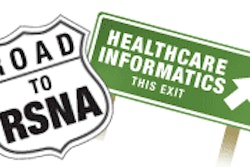The Internet holds the key for more efficient workflow and reporting, according to two recent studies in the American Journal of Roentgenology and the Journal of the American College of Radiology.
First, researchers from Johns Hopkins University in Baltimore shared their experience with an in-house, Internet-based radiology order-entry, reporting, and workflow management system. They found that this system, called 3RADS, formalized their previously casual communication process during off-hours.
In the second paper, a multi-institutional group has proposed using the Web to open a new channel of communication directly from the radiologist to the patient.
3RADS
"Clinical histories provided either on paper requisition or even on computer order-entry systems are often inadequate," commented Dr. Krishna Juluru and Dr. John Eng. This is especially true between the hours of 5 p.m. and 7:30 a.m., when preliminary reports are delivered verbally and may lack proper documentation (AJR, March 2005, Vol. 184:3, pp. 1017-1020).
To address this problem, Juluru and Eng created the multitasking 3RADS. A FileMaker database on a Microsoft Windows platform was used to develop 3RADS. The minimal hardware requirements for 3RADS included an Intel-compatible computer with 90 MHz processor and 32 MB of random access memory.
User authentication (user name and password) was done through a Java applet. The system was accessible by radiologists, technologists, and referring physicians. The system was implemented hospital-wide in 2003 at Johns Hopkins for sonography and CT exam requests.
Once he or she is logged in, the clinician can request a study based on preset ordering guidelines. "For a CT study to evaluate a suspected pulmonary embolism, for example, the clinician is made aware that central lines cannot be used for contrast injection," the authors explained. The clinician can then track the progress of this order with 3RADS.
The radiologist can view the studies in the cue, check the status of each study, enter protocol instructions for the technologist, and generate a preliminary report. 3RADS offers the technologist a technique-specific work list of studies.
Streamlining the communication pathway between clinicians, radiologists, and technologists has been one of most successful components of 3RADS, the authors stated. Significant imaging findings were verbally communicated to the referring physician, and this report was then documented in the 3RADS system. More importantly, insignificant findings were no longer clogging the system.
"Instead of requiring multiple telephone calls between clinician, radiologist, and technologist, a typical study performed overnight that has insignificant findings now requires no telephone call," they said.
Other benefits included:
- Reduction in the number of patients who were not properly prepared for an imaging exam
- Reduction in the number of night calls that radiologists had to answer to discuss findings with a clinician
- Reduction in the number of phone calls a clinician had to place to learn more about imaging results
- Educational tool for residents to compare preliminary reports to the final report by the attending radiologist
Finally, the authors pointed out that 3RADS offers the same advantages as a more sophisticated system that links RIS and PACS, but it does so at "a fraction of the cost."
"Although our institution's RIS does offer basic order-entry features to technologists, it is not easily adaptable to provide an environment for physician order entry," they explained.
In an email to AuntMinnie.com, Juluru said that the 3RADS project has piqued the interest of the hospital's billing department, who has used the documents to help with reimbursement.
Juluru added that 3RADS would be of value to other radiology departments, but his group has not explored the possibility of taking the system outside Johns Hopkins. However, plans are currently under way to extend the 3RADS system to provide full-time ordering for all imaging studies at their institution.
'Patient-centered care'
Mammography may be a hotbed of controversy, but there is one area that this particular branch of imaging has made indisputable inroads -- fostering a relationship between the radiologist and the patient. The Mammography Quality Standards Reauthorization Act (MQSRA) mandates that breast imagers provide clear reports to women as their test results.
Radiology as a whole would be wise to follow mammography's example and begin communicating directly with patients, according to Dr. Annette Johnson and colleagues. They recommended that giving patients Internet access to their records would be the best option.
"The idea that patients should have direct access to their test results represents a rather radical change in the system of health care delivery in radiology, breaking with the traditional view of referring physicians as radiologists' 'customers' and instead viewing patients as 'co-customers' and equally partners," wrote Johnson, who is from Indiana University Radiology Education and Research Institute in Indianapolis (JACR, February 2005, Vol. 2:2, pp. 168-173).
Johnson's co-authors are Dr. Kimberly Applegate from Riley Hospital for Children in Indianapolis and Dr. Hugh Hawkins from Middletown Regional Hospital in Middletown, OH.
"We suggest that Internet access might have substantial merit, because it allows for secure access to information ... and is probably relatively inexpensive compared with other methods," they added.
The ultimate goal would be the "timely and appropriate" dissemination of test results as outlined in a quality of healthcare report by the Institute of Medicine (IOM). The authors proposed a three-prong continuous quality improvement (CQI) program focusing on safety, timeliness, and patient-centered care.
With regard to safety, the authors pointed out that patients are the least likely to forget that a diagnostic test was performed, what the treatment recommendations were, and whether follow-up was required.
"In a typical system, it is relatively easy for important diagnostic information to be lost, overlooked ... or ignored. To better ensure safety, patients need to be fully informed," they explained.
The second aspect of CQI is timeliness, which can be met by sending simultaneous reports to the clinicians and patients. This would reduce the delays in diagnosis that cause unnecessary physical and emotion distress.
Finally, there is patient-centered care. The authors questioned the current setup, which puts patients completely at the mercy of caregivers for accurate information. Instead, they asked, "Do patients not have the right to seek advice directly from all physicians involved in their care?"
They cited a reporting system that was used at a site where co-author Hawkins' read mammograms. At this center, imaging reports were sent directly to the patient. During the four years that Hawkins' worked with this system, there were very few "dysfunctional situations" created by allowing the patients to have access. When patients did have questions, they generally related to medical terminology and were easily answered, the authors said.
The advantages to radiologists of this direct communication with patients includes:
- Conveying results in an effective, timely, and standardized way
- Making patients aware of the radiology's contribution to their healthcare
- Developing a service profile that is appreciated by patients, payors, and referring physicians
The disadvantages of this CQI model relate to that service profile. First, how will it affect the relationship between imaging and referring clinicians? To address this issue, Johnson has proposed a study that would evaluate physician preferences for simultaneous reporting.
In terms of payors and their concern about the legal aspects of this model, the authors pointed out that, under HIPAA, patients already have the right to access their medical records. Finally, there is a cost involved in setting up the patient-accessible Web sites. However, HIPAA standards allow centers to charge patients a fee for preparing summary statements.
"The traditional paternalistic practice style is increasingly unacceptable to patients," they concluded. "Increased patient satisfaction is related to increased adherence to medical advice and a lower propensity to sue for malpractice."
By Shalmali Pal
AuntMinnie.com staff writer
March 10, 2005
Related Reading
Web-based application nets teleradiology benefits, January 31, 2005
'Pleased to meet you' -- academic imaging center moves market with personal touch, December 2, 2004
Security in the wired or wireless world: users are the weakest link, May 24, 2004
'Safety net' system stops patients from falling into follow-up black hole, May 5, 2004
Copyright © 2005 AuntMinnie.com



















